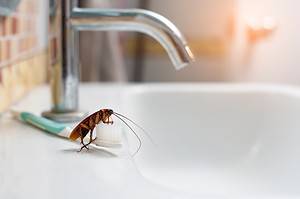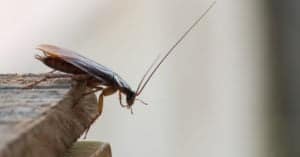The state of Virginia occupies the seventh spot on the “Most Likely to Have Cockroaches” list. Thus, encountering cockroaches in your home in Virginia is quite probable. But when is cockroach season?
Unlike some seasonal pests, cockroaches remain active for nearly the whole year. However, their most active season in Virginia span from March through December. These creepy critters are most unsavory home invaders, just as resilient as they are widespread. Below is everything you should know about cockroach season in Virginia.

Cockroach infestation is a nuisance and can spread diseases.
©Naamtoey/Shutterstock.com
Why are Cockroaches Common in Virginia?
Cockroaches’ activity slows during winter months. However, this reason is not enough to stop them completely. Thus, Virginia residents should prepare for a long cockroach season that starts in March.
There are several reasons why cockroaches are common in Virginia.
Warm Climate
Virginia’s warm climate provides a favorable environment for cockroaches to thrive.
Availability of Food
Cockroaches like to stay near food and water sources. Thus, the availability of food in Virginia attracts these pests.
Plenty of Trees
Trees and forests provide a shelter and hiding place for cockroaches. In other words, trees enable cockroaches to breed and infiltrate homes.
What Types of Cockroaches Are Common in Virginia?
Virginia has the most prevalent species of cockroaches. Identifying cockroaches is the initial step in eradicating them from your house.
1. American Cockroach
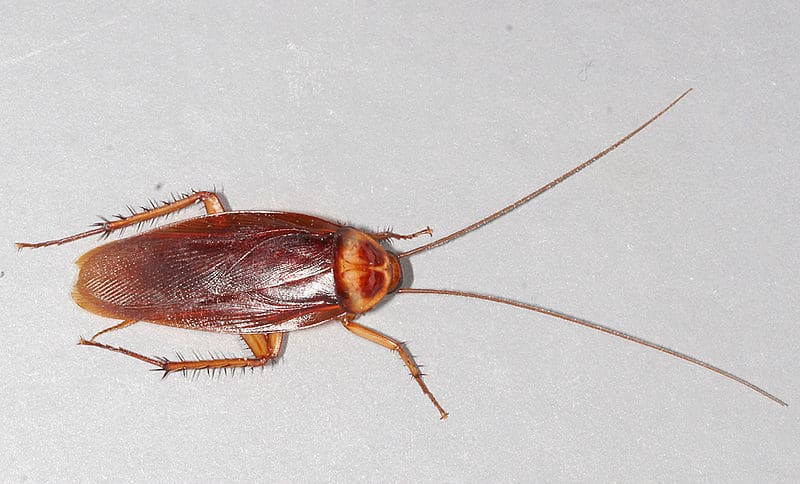
The
American cockroach
features glossy reddish-brown wings and two dark red brown patches at the center.
©Gary Alpert at the English language Wikipedia / Creative Commons
Common names: ship cockroach, Virginia cockroach, Bombay canary, kakerlac
Scientific Name: Periplaneta Americana
The American cockroach features glossy reddish-brown wings and two dark red brown patches at the center. The males exhibit wings that surpass their abdomen. The American cockroach is one of Virginia’s largest species. They are also fast runners and strong fliers. You can detect when their population is high due to their pungent smell.
Origin
Contrary to its name, the American cockroach is not native to America but comes from the Middle East and Africa. Ships brought these cockroaches to America a hundred years ago.
Behavior
The American cockroach is active throughout the year. You will find them in areas of Virginia that are warm and moist. Their perfect breeding spots are homes and commercial spaces. You are likely to find these cockroaches in basements, crawl spaces, and foundation cracks.
Diet
American cockroaches’ indiscriminate diet consists of almost anything they come across, including leather, dry skin, dead animals, and other cockroaches.
Health Hazards
Besides causing a foul smell, American cockroaches carry bacteria, like Salmonella. They deposit the bacteria on food, causing food poisoning and infections. Additionally, the excrement of cockroaches can lead to allergic reactions and asthma.
American cockroaches are resilient creatures. They can survive without food for over a month. They can also survive being under water for half an hour. This makes them challenging to eradicate. Thus, professional pest control is necessary.
2. German Cockroach
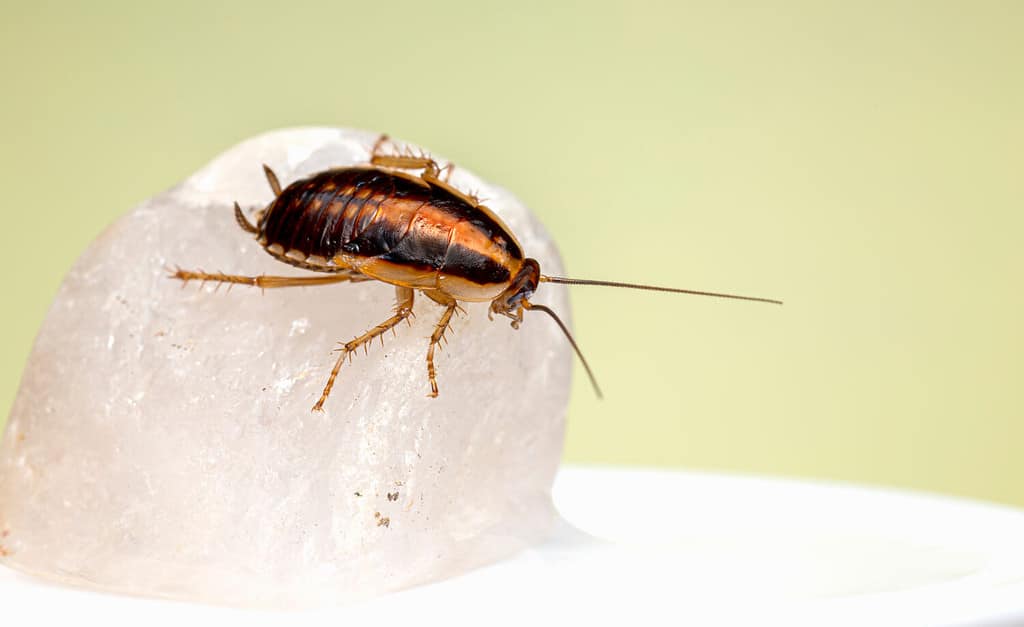
German cockroaches are prevalent in Virginia.
©Erik Karits/Shutterstock.com
Scientific Name: Blattella germanica
The German cockroach is a common pest in Virginia. These pests are sensitive to the cold and thrive in warm climates. Their heads have two dark streaks, while their body color is either tan or pale brown.
Females are a dark brown shade with broader abdomens. Males have slender, tapering abdomens with a yellowish underside.
Origin
Despite its name, the German cockroach’s origin is not Germany but Southeast China.
Activity
German cockroaches are year-round pests that invade various places such as houses, hotels, apartments, restaurants, and hospitals.
They come out at night to look for food and water and feed on plants. If you turn on the light, they scurry away. These pests hide in tight spaces around sinks and walls during the day, which makes it challenging to detect an infestation. Thus, it is essential to keep spaces clean, throw away food wrappers, and seal cracks.
Diet
The German cockroach likes to eat starchy, sugary, and fatty foods. Without food, they may eat household items like toothpaste and soap.
3. Oriental Cockroach
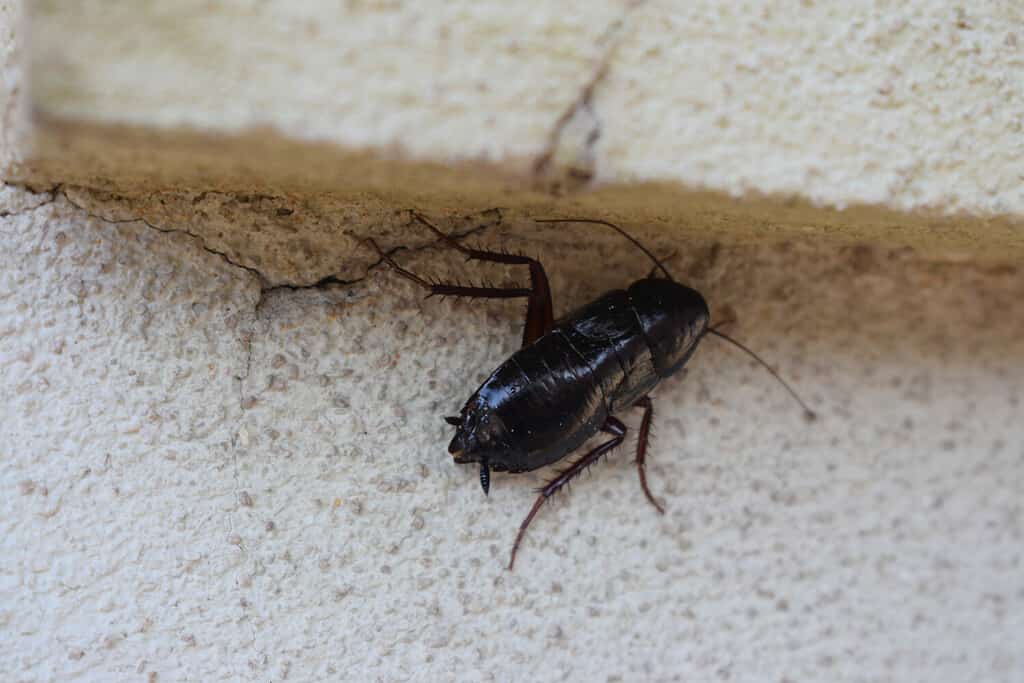
©Furiarossa/Shutterstock.com
Common Names: waterbug, black beetle
The Oriental cockroach’s body is dark reddish-brown to blackish brown in color. It has a distinctive shiny appearance. The males have wings covering a large part of their abdomen, while females have shorter wings.
Activity
These cockroaches hide in dark and damp areas. They are flightless, slow-moving, and poor climbers. Because they prefer moist environments, you will find them in sewers, crawl spaces, and basements.
Diet
Oriental cockroaches feed on decaying plant matter, animal remains, and starchy human leftovers. Thus, you can also find these cockroaches under mulch, dried leaves, and bushes.
Health Hazard
The Oriental cockroach is notorious for being a household pest. You can identify its presence by the strong odor it produces.
Additionally, this species is among the filthiest cockroaches in Virginia. They can spread viruses and bacteria to food, countertops, and utensils. This species transmits foodborne illnesses such as E.Coli, Salmonella, and Dysentery.
To avoid their presence, you should keep surrounding clean and dry, dispose of garbage, and seal all crevices.
4. Pennsylvania Wood

The Pennsylvania wood cockroach lives in forested areas. You will find it on lower branches and on tree trunks of elm and oak trees.
©Melinda Fawver/Shutterstock.com
Common Name: Pennsylvanian cockroach
Scientific Name: Parcoblatta Pennsylvania
The Pennsylvania wood is dark brown. Males have yellowish sides of the thorax, while females have short, useless wings. Males have developed wings that are longer than their abdomens.
Activity
The Pennsylvania wood cockroach lives in forested areas. You will find it on lower branches and on tree trunks of elm and oak trees. These cockroaches are active at night, and you seldom see them during the day.
Unlike other cockroaches, the Pennsylvania wood prefers cooler temperatures. It cannot survive indoors for long due to a lack of humidity.
Diet
These species feed on decomposing organic matter like dead plants, manure, and compost. They are better suited to their natural habitat, where they can play their ecological role in decomposition.
5. The Brown-Banded Cockroach
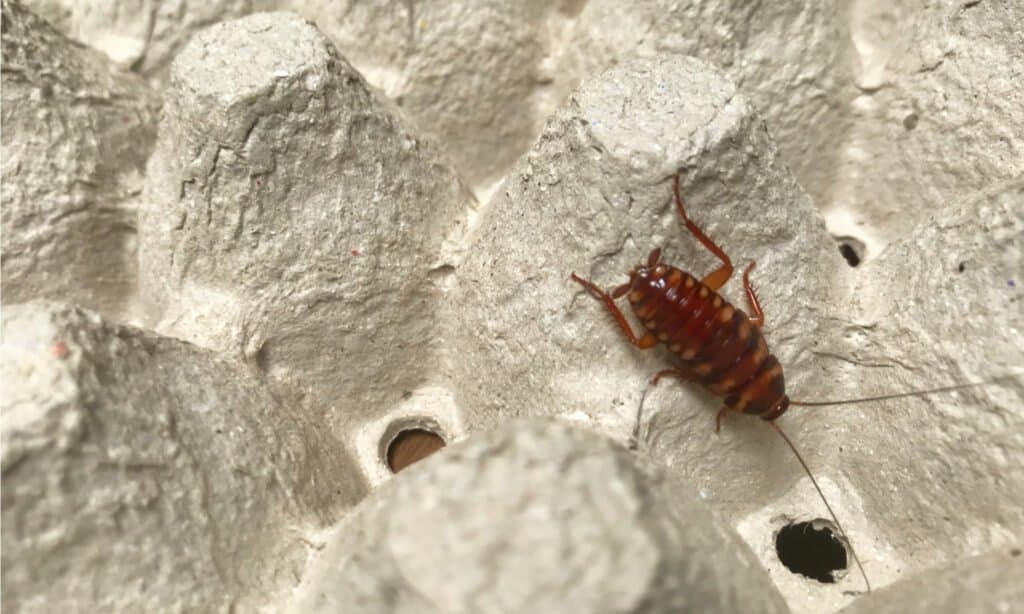
Brown-banded cockroaches can survive with less moisture. Because of this, they can occupy areas inside your home where others can’t.
©Freedom my wing/Shutterstock.com
Scientific Name: Supella longipalpa
The brown-banded cockroach is a small species found in Virginia. Their wings and abdomen display two light-colored bands. Their body coloration ranges from tan to light brown. The males’ wings are slender and cover their core. The females have broader bellies and shorter wings. Hence, they appear darker.
Activity
Brown-banded cockroaches can survive with less moisture. Because of this, they can occupy areas inside your home where other types of cockroaches cannot reside. You will find these cockroaches hiding in cabinets and appliances. Since they avoid light, they are not seen during the daytime. Droppings and shed skins are significant signs of infestation.
Diet
The brown-banded cockroach’s diet is diverse, encompassing everything from books, boxes, and sewage. They are opportunistic eaters and will consume anything they come across.
Health Hazard
These cockroaches pose a significant threat to humans as they carry harmful microorganisms and can spread diseases. Thus, their presence can be challenging for humans to deal with.
Identifying Cockroach Infestation in Virginia
Simply put, cockroaches are disgusting. They thrive in dirty and drab environments like unclean bathrooms, garbage bins, and sewers.
Here are some of the most common signs that you may have a cockroach infestation in Virginia:
Exoskeletons
Cockroaches shed their exoskeletons as part of their molting process. The exoskeletons can resemble black or brown shells. You will likely find exoskeletons where there is an infestation.
Cockroach Feces
Cockroach droppings resemble small black pepper grains in size and color. You can find these droppings in hidden locations, such as under tables and at the back of drawers.
Unpleasant Odor
Cockroaches’ exoskeletons emit a musty smell. This smell is noticeable in severe infestation cases.
Observing Live Cockroaches
In case of an infestation, you will see cockroaches outside of their hiding places.
How Dangerous Are Cockroaches in Virginia?
Cockroaches expose themselves to various pathogens and parasites. Thus, they are disease vectors of the worst kind. They spread disease by carrying illnesses on their exterior and contaminating surfaces and food sources.
Some of the diseases they carry include:
- Salmonellosis
- Dysentery
- Giardia
- Listeriosis
- E. coli.
Cockroach exoskeletons trigger asthma and allergy attacks in the young and elderly. Therefore, cockroaches pose significant health risks for homeowners and their families.
How to Prevent Cockroach Infestation in Virginia
Below are several steps to prevent cockroaches from infesting your property during cockroach season:
- Repair any leaky pipes to remove sources of water, which cockroaches need to survive.
- Do not leave pet food out overnight. Store all food in the refrigerator or airtight containers.
- Use a dehumidifier to reduce humidity levels in your home and dry out damp areas.
- Vacuum and keep storage areas clutter-free and well-organized.
- Inspect potted plants for cockroaches before bringing them into your house.
- Seal any crevices and cracks in the foundation. Cockroaches can enter through the tiniest openings.
- Weather stripping around windows and doors prevents them from entering your home.
- Keep woodpiles and garbage cans away from your home’s exterior.
- Throw away cardboard boxes immediately after opening. Many cockroaches love cardboard.
The photo featured at the top of this post is © IrinaK/Shutterstock.com
Thank you for reading! Have some feedback for us? Contact the AZ Animals editorial team.




